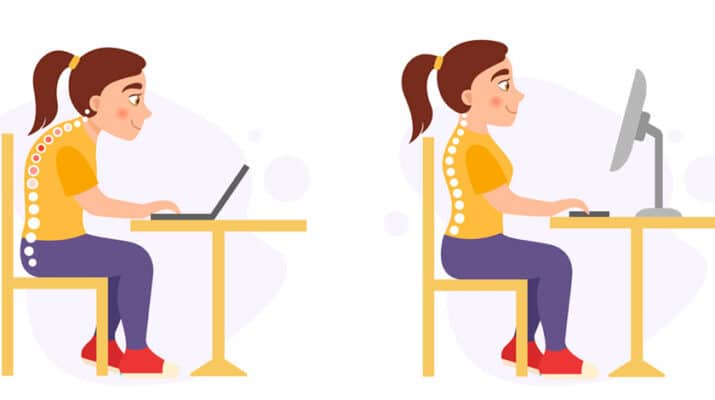Arrange your home workspace for comfort, good health
By Deborah Jeanne Sergeant
Ergonomics in the workplace ensures workstations help keep employees in comfortable positions that fit their size and helps them perform work without strain. The principles are just as important for children who now spend many more schooldays at home, more likely than not working at makeshift desks — or no desk at all. Most children at home are working on laptops, which were meant for short periods of work, not for hours.
You may not realize right away that your children are not comfortable in their home education set-up since the effects of poor posture are not as quickly evident in children most of the time. They are known for sleeping and sitting in odd positions and not feeling sore as an adult would. However, Jeana Voorhies, doctor of chiropractic and assistant professor of chiropractic clinical sciences at New York Chiropractic College in Seneca Falls, said that since children are still growing, “it can have an impact on neurological development. It puts some strain on t hose structures. Over time, especially as a child, we’re setting them up for some bad habits and potential long-term effects.”
Ideally, parents should have a workspace the right size for each child; however, this gets complicated as finances and space are strained in dedicated space for each child and possibly the parents as they may be working from home as well.
Voorhies said that the 90/90/90 rule is the goal. When seated, the back and hips, knees and ankles should each be bent at a 90-degree angle.
The line of vision is also important.
“We don’t want to be looking down for too long,” Voorhis said. “Ideally, that screen should be right in your line of vision. That can be simple by putting books under the laptop. It brings it up to the line of vision so the neck is in a neutral position.”
In a regular school day, most children move around more than they may move at home. Ordinarily, they may join in activities in the classroom, PE, athletics or at least moving from class to class, depending upon their age. Voorhis said that at home, children can move their laptop to different positions such as standing to break up their day.
“One position I love to let their children do is to take the tablet or lap top and lie on their tummy, propped on their elbows,” she added. “In that position, you take your neck and spine out of that flexed posture. It gets the spine into an extended position.”
At any opportunity, children should stretch and get active, including after the schoolwork is done.
Otherwise, sitting in a hunched over posture can cause upper crossed syndrome. A deformation of the neck, pectoral and back muscles, upper cross syndrome leads to many problems such as headaches originating from the neck and pectoral muscles.
Bridget Hughes, pediatrician at UBMC Pediatrics and is a clinical assistant professor at University at Buffalo, said that many children are coming to the office with headaches, backaches and poor sleep that have worsened during the pandemic.
“It can relate to the fact that they’re sitting in a chair all day that isn’t great fitting or they’re hunched over on the couch,” Hughes said. “We recommend working with what you have at home to get your kids in the best, most supportive environment.”
This could include a chair with back support and using firm cushions and an adjustable chair to raise them to the correct height.
“Definitely sitting on the couch or bed, or not on a set workspace, can contribute to problems,” Hughes said.
To counteract the overall lack of movement in the day, Hughes recommends breaks for children that include walking around the house, running up and down the stairs, jumping jacks or a family dance party.

